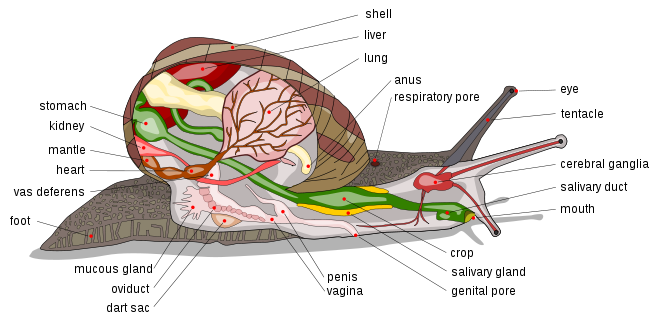Nutrition
Daedalochila auriformis gets its food by using its foot for locomotion to find nutrients and to consume food. Gastropods also have radula which are chitinous teeth, an organ used for scraping, tearing, and drilling into prey. These snails are land-dwelling species and can chew up leaves, bark, fruit and decomposing animals and also consumes organic matter or humus. Humus refers to any organic matter that has reached a point of stability, where it won't break down any further and might, if conditions do not change, remain as it is for years. By consuming dead organic matter, snails contribute to decomposition and the nutrient cycles and are an important aspect of the ecosystem. (Lab manual)
Daedalochila auriformis
mouths have
special glands that
produces mucus so that the food can stick. Cilia
then drives the mucus along with the food towards the
stomach. The food particles are sorted
by another group of cilia, which send the smaller food pieces to the prostyle
so that eventually they are excreted, while the larger food
particles are sent to the
stomach's cecum to
be digested. The anus is in
the part of the mantle cavity that is then swep t by the outgoing
current created by the gills. (Wikimedia foundation,2012)
t by the outgoing
current created by the gills. (Wikimedia foundation,2012)
When food sources are very low in the
summer or spring months, they may voluntarily put their body
into a state of hibernation as well. This allows them to
conserve energy and not need to forage for additional food. This
is a mechanism that allows them to be able to survive in
difficult conditions of drought. They will consume more food at
the colder months ahead come. This is so they can store up fat
reserves to live on while they hibernate during the winter.
(Wikimedia foundation,2012)
The primary organs of excretion in gastropods are nephridia, which produce either ammonia or uric acid as a waste product. The nephridium also plays an important role in maintaining water balance in freshwater and terrestrial species. Additional organs of excretion, at least in some species, include pericardial glands in the body cavity, and digestive glands opening into the stomach. Two diverticular glands open into the stomach, enzymes in the stomach helps to break down the food.
Daedalochila auriformis
have an open circulatory system – the blood is not confined to
the heart and vessels but percolates under low pressure through
irregular channels and sinuses in the tissues.
These channels and sinuses make up the hemocoel, which is
a major body cavity in these mollusks and is larger and far more
important than the coelom.